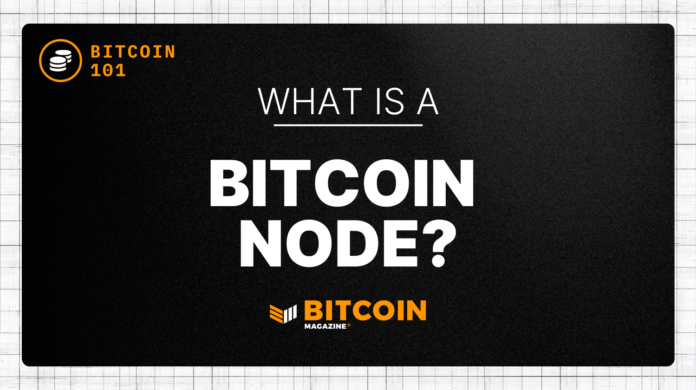Nodes are an essential component of all computer networks. In computation, a node is an electronic device that is part of a network and can create, receive or transfer data through a transmission channel.
A Bitcoin node hosts the rules that govern the Bitcoin network, such as bitcoin’s total supply, how often coins are issued, and what parameters transactions have to follow to be considered valid. They are the backbone of the network and play a fundamental role of securing and maintaining it. Full nodes validate and store the complete history of the blockchain’s transactions. This article will take you through the types of nodes, why they are essential, and why you should be running one yourself.
The set of nodes constitutes the Bitcoin blockchain, and they are responsible for maintaining the correct database of past transactions in a distributed way. They validate transactions according to the protocol rules that are set in stone in the Bitcoin software code.
Anyone can join the network by downloading the software and operating a Bitcoin node, and such a system is what makes Bitcoin unique. The Bitcoin network uses a distributed network of nodes to function, instead of relying on a trusted central entity. For the first time in history, central administrators such as banks and various financial institutions are no longer required to secure people’s money.
The problem with trusting a centralized institution to manage our money is that we have to abide by the rules they establish, and we don’t have ultimate control or ownership over our own assets. Bitcoin was created in the wake of the 2008 financial crisis that led to millions worldwide losing their jobs and life savings. When Satoshi Nakamoto developed Bitcoin, he envisioned an economic system that could allow people to manage their finances in a trustless way, replacing a central entity with a network of nodes and miners.
Two Types Of Nodes
Bitcoin is run over a peer-to-peer (P2P) network of nodes. Anyone can download the free, open-source Bitcoin software and become a node responsible for processing transactions and maintaining all ownership records.
All nodes are treated equally, and no single node needs to be trusted. However, the system is based on the assumption that most computing power (at least 51%) will come from honest nodes.
There are two types of nodes, full and light nodes:
- Full nodes: A full node, or a “full client,” is a computer connected to the Bitcoin network which enforces its rules. It stores the entire history of Bitcoin transactions and can validate transactions and blocks, helping the network verify them by rerouting full nodes to be verified to other full nodes.
You can think of a standalone email server handling all aspects of the protocol without relying on any other server or third-party service. Full nodes store the private keys locally and are never communicated to the network. They are the backbone of the Bitcoin blockchain, and the more full nodes that join the network, the more stable, healthy, and secure Bitcoin becomes.
- Light nodes: A light node, or “lightweight client,” doesn’t store a full copy of all transactions and must trust third-party servers for validation. It stores the user’s wallet but must trust third parties to receive block data.
You can think of a standalone email client that connects to a mail server to access a mailbox and relies on a third party for interactions with the network. Light nodes store private keys locally, just like full clients.
The Role Of Miners Versus Nodes
The role of miners is to add new blocks of transactions to the blockchain and issue new bitcoin with each block, whereas the role of nodes is to secure the Bitcoin network and have a real-time record of all the transactions.
When a bitcoin transaction is entered, and the money is transferred from one wallet to another, the details of such transactions are propagated through the network to a few thousand Bitcoin nodes, not all of the nodes. They will double-check that the transmitter has the bitcoin sent, and if all is good with the transaction, they will pass it on to other nodes. These will do the same and pass it on to other nodes until all the nodes receive the transaction details.
Once all the nodes verify the transaction, this is sent to a memory pool, aka the “mempool,” where many other transactions are waiting to be confirmed and then added to the blockchain.
To take the pending transactions, put them together in a block and add them to the blockchain, miners first need access to the transaction submissions that sit on the mempool. For this reason, miners need to be nodes before being miners. The miner who proves the hard work (proof of work) and finds the solution to generate a new block of transactions shares it with the network of nodes for approval. Therefore, the nodes have the final decision to verify and approve transactions in that block.
Learn More >> Bitcoin Mining – The Complete Guide
How Many Nodes Are There?
While there are no irrefutable methods for counting the number of Bitcoin nodes at any time, websites like Bitnodes.io estimates that there are more than 17,000 Bitcoin nodes, with the large majority of them being using the Bitcoin Core software. Nearly 46% of them are run privately, likely connected through TOR and it’s therefore impossible to know their location.
The rest are distributed in North America (15% in the United States) and Europe (Germany, France, and the Netherlands together totalling approximately 18% of the European nodes). In the top 20 countries, notably, there is also Russia (ninth), the Czech Republic (13th) and China (18th).
Why You Should Run a Node
Whilst there is no immediate financial incentive in the form of cash flow for running a Bitcoin node, there is a much more important financial incentive to protect your investment. By running a node, you have a say in the network’s governance, which means your node is one vote in any change to the Bitcoin network that must be agreed upon by most active nodes or miners. A vote of support can be signaled in various ways. In the case of Taproot, for instance, miners signaled their support by putting a “4” at the end of the version bits (0x2f900004) in the block they mined.
In the event of disagreement between network participants and a chain split becomes necessary, you can only choose which chain you want to support if you’re running a full node. This is what happened in 2017, for instance, during a Bitcoin update called SegWit and the infamous blocksize war, when the Bitcoin chain was split and Bitcoin Cash was created. The nodes were essential in protecting Bitcoin against a number of developers and Bitcoin companies who sought to increase the memory size of the blocks.
Running a node is affordable since you can use any basic computer with just 350 GB, 2 GB RAM, and an unmetered internet connection.
The following are the main reasons you should run a node, other than what’s been highlighted so far:
Privacy
If you’re not running your own node, then every time you’re using bitcoin, you’re relying on a third-party node to verify the balance on your wallet or the status of your transaction. On the other hand, when you’re running your own node, your transactions are broadcast directly from your node without relying on any service that might access and leak private information.
By running your own node, you can verify the status of your transaction and will also bypass services like Block Explorer, which is monitored by surveillance companies’ nodes. The service can — intentionally or unintentionally — track your transaction history and balances and link it to your IP address, thus providing your private data to governments for tax and even confiscation purposes, or to hackers that could extort you or trick you out of your bitcoin.
Security
Nodes contribute to the security and decentralization of the network. The more nodes participate in the network, and the more secure and decentralized Bitcoin will be. Nodes also guarantee that users and miners comply with the network’s protocol rules.
Trustless
Trust is the fundamental criterion for every social interaction, and most relationships or partnerships fail when trust is broken. We must trust a third party to manage our traditional finances or a lawyer for our legal issues. But Bitcoin is trustless, meaning that participants in the network do not need to trust anyone or any central authority to get their information sent from one node to another and confirmed by the network.
By running a node, you verify all transactions on the Bitcoin blockchain for yourself while thousands of nodes and miners confirm that the transaction was legitimate and was not spent twice, and then they broadcast it to the blockchain.
Strengthens The Network
Bitcoin decentralization is secured by a large number of globally distributed nodes and miners that propagate transactions efficiently to the whole network to prevent coordinated attacks.
The larger the number of globally distributed nodes, the harder it is to shut the network down. For instance, in the event that several governments were to lead a large-scale campaign to shut down the nodes, they would need to close down every single one of them – including those in outer space – to halt Bitcoin for good.
How To Get Started
The complete history of the Bitcoin blockchain can be downloaded on software provided by several different clients. However, the highest number of full nodes use Bitcoin Core.
Running a node with Bitcoin Core is a relatively simple and inexpensive process. However, before viewing how to build your own node with Bitcoin’s most popular program, you should also be aware that you can buy a node and use the “plug and play” method, so called to highlight how straightforward the process is.
- Buy A Node (Plug-And-Play)
Plug-and-play allows you to simply choose a node provider — like RoninDojo’s Tanto, myNode Model One, nodl One, The Bitcoin Machine, or BTC Cube — plug it in, and you are ready to start running your own node. It’s that simple. The trade-off for running this type of node is the cost — which may vary from $200 to $700 — and security. Just like with your hardware wallet, you’ll have to be careful when ordering your node box that no malicious components are installed to leak your privacy or steal your bitcoin. Also, like with a hardware wallet, consider receiving the box at a different address than your home one for better security.
- Build A Node
Running Bitcoin Core software to build your node is easy and cheaper than buying a node. However, you should always consider the electricity consumed for running high-power required software, which could elevate your monthly bill.
To run your node, simply download the Bitcoin Core software on your device. It will copy the blockchain from other nodes until your node is enabled to verify each block itself. All you have to do is leave the node on and see new blocks with new transactions from the mempool being received roughly every 10 minutes. Your node is now participating in the network, checking if the subsequent blocks are valid and adding it to its copy of the blockchain.
Summary
Ultimately, it is recommended for every Bitcoin supporter to run their own node because it is relatively cheap, benefits the user’s privacy and security, and significantly strengthens the Bitcoin network.
Nodes are the backbone of the BTC blockchain, and if the purpose of Bitcoin is to replace banks with a decentralized infrastructure, it needs to rely on a network of nodes and miners to ensure everyone is following the protocol’s rules, verifying transactions, and that there’s no double-spending involved. The self-sovereign Bitcoiners run their own node because they can control their finances and are enabled to prove their ownership of bitcoin without relying on any third party.


